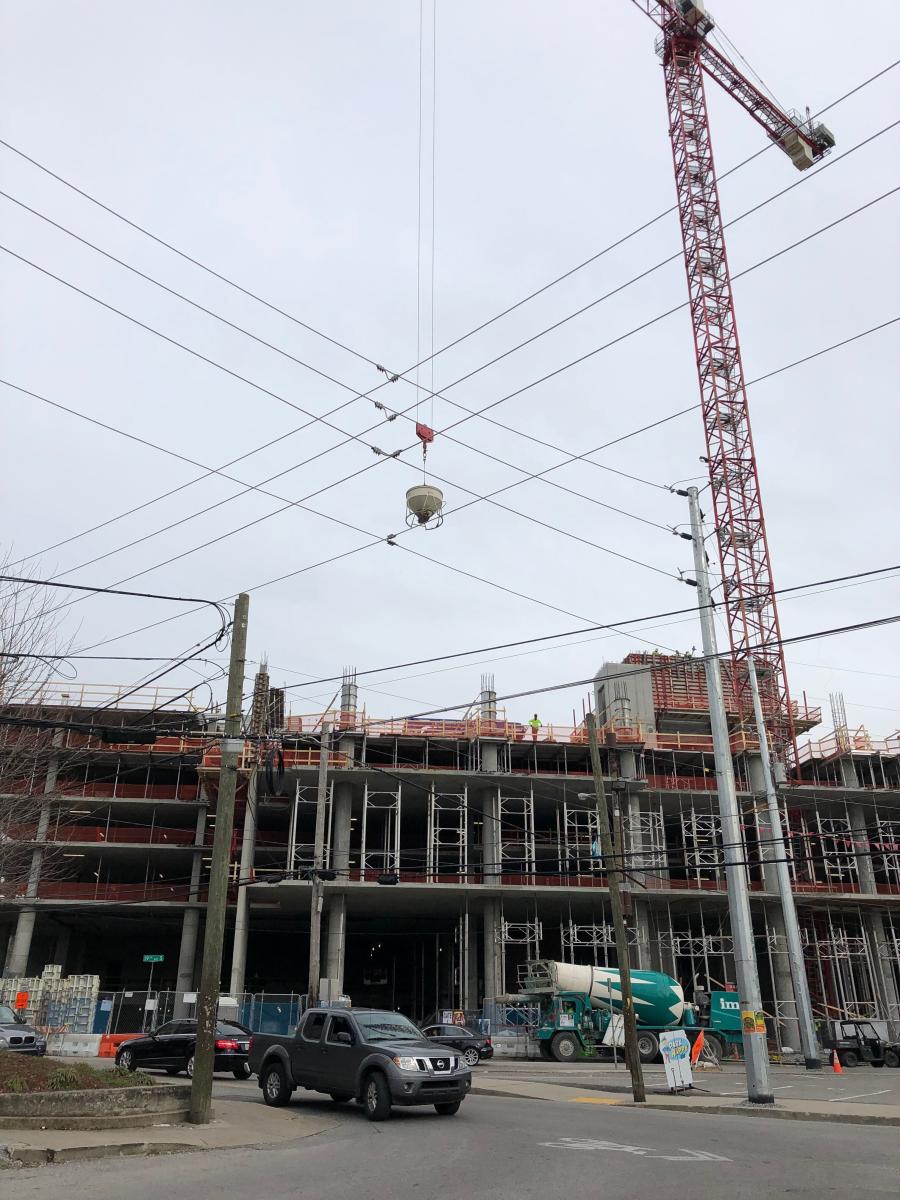McHugh Construction Co. crews are using one crane — a Potain MD485 — for the erection of the structure, which will be the second-largest apartment building in Nashville when completed in July 2020.
James McHugh Construction Co. is building the $80 million-plus Kenect Nashville, a 20-story, 420-unit high-rise that will be the second largest apartment building in Nashville, Tenn., when completed in July 2020.
Chicago-based Akara Partners, the developer behind the 600,000-sq.-ft. Midtown structure, secured the building permit from the city's Metro Planning Commission in 2017, and construction began last April. In 2016, Akara Partners built the Kenect Chicago. For their Nashville project, the developer created AP 1815 Division Nashville Property LLC.
The rectangular-shaped building sits on a 1.19-acre, three-parcel site at the southeast corner of 19th Avenue South (808 and 812) and 1815 Division Street. It includes a 24,000-sq.-ft. retail space, five floors of above-ground parking and 424 spots reserved exclusively for bicycles. The property, adjacent to Music Row, was home to the offices of Spirit Music Nashville and the vacant Crittenton Building.
"Nashville is a great story in job and population growth," Akara Partners CEO Rajen Shastri said. "There continues to be strong demand for apartments, especially in Midtown, a live-work-play neighborhood that appeals to growing companies and millennial renters."
The tower will have 246 studios, 134 one-bedroom units and 40 three-bedroom apartments. Its amenities include community lounges and work spaces, a swimming pool, a fitness center, outdoor fire pits and grills. Aesthetically it combines several architectural elements including a sleek, mostly-glass façade coupled with metal panels and a Z-purlin garage screening system.
Chicago-based Perkins+Will serves as project architect and Nashville-based Smith Gee Studio is the architect-of-record. Hawkins Partners Inc. (Nashville) is the landscape architect while Barge Cauthen & Associates is providing civil engineering services. To prepare the site for construction, McHugh crews had to complete demolition of two 2,000-square-foot structures.
"Existing power poles that had to be relocated complicated the excavation and foundation work," said Ryan Keane, senior project manager for McHugh Construction. "We were able to limit the exposure to surrounding sites and utilities by excavating the rock using mechanical methods in lieu of blasting."
The earth work generated around 9,200 cu. yds. of earth and rock. The soil was used as additional cover for landfill, and the rock was recycled and crushed.
"The original design called for 50 caissons," explained Keane. "In order to save time and money, we pre-cored each footing location and the Geotechnical Engineer (ECS) analyzed it for bearing capacity and depth of acceptable bearing strata. We then realized we could eliminate all of the caissons and mechanically excavate the footings to the acceptable bearing elevation as determined by ECS."
The foundation was completed in three months, and to date McHugh crews have completed six floors, with approximately 75 percent of construction work remaining. The building's topout is scheduled for mid-October 2019.
"The site is in very close proximity to a number of local businesses and residential buildings," Keane said. "In Nashville, concrete pours are at night and in the early morning in order to limit the number of concrete trucks on the local streets during the daytime hours. We have been very forthright with the neighbors as to when the pours will occur — the constant communication is a must."
Crews are using one crane — a Potain MD485 — for the erection of the building. A dual man/material hoist will bring workers and materials to the completed floors during construction. "We'll be utilizing an external buckhoist to distribute construction materials and workers to and from each floor." Keane said.
McHugh is looking forward to the completion of the project, with safety being a priority.
"All team members conduct regular safety audits," Keane declared. "We have a full-time safety manager on site, and safety orientation for all workers is required. We also proudly empower our crew members — no matter their tenure — to take action if and when they feel work site safety is compromised. Everyone on the job is a safety manager."
Peak work days will see 150 construction personnel on site. Subcontractors include: Alpha Insulation and Waterproofing for waterproofing; Aqua Design Systems for the pool; Bernhard/MCC (HVAC); Century Fire Protection for fire protection); Feyen Zylstra for electrical; John McDougall for metal panels; Jollay Masonry for masonry; Lithko Holdings for concrete; Mitchell Mechanical, Birmingham for plumbing; Otis Elevator for elevators; and SES Group for miscellaneous metals.
New construction materials include 22,500 cu. yds. of concrete, 1,500 tons of rebar, and 75,000-sq.-ft. of glass. In addition to the Potain MD485 crane, McHugh is using four Case excavators with three rock breaker attachments and a Cat D6 dozer.
"Our Nashville operations are unique in that much of our equipment is rented, so repairs are performed by rental supply companies," Keane said. "In Chicago, we employ a staff of mechanics to service multiple pieces of equipment including mobile concrete pumps, placing booms, stationary concrete pumps, semi-trucks, etc."
In Tennessee, McHugh rents equipment from dealerships such as Sunbelt, Ram Tool, United Rentals, Care Supply, White Cap, McDonough Hoist, USA Hoist, Maxim Crane, Amquip and Solley Crane.
"We have a very positive working relationship with our equipment dealerships," Keane asserted. "And that's key as we work to further establish our presence in a relatively new market." CEG
Irwin Rapoport
A journalist who started his career at a weekly community newspaper, Irwin Rapoport has written about construction and architecture for more than 15 years, as well as a variety of other subjects, such as recycling, environmental issues, business supply chains, property development, pulp and paper, agriculture, solar power and energy, and education. Getting the story right and illustrating the hard work and professionalism that goes into completing road, bridge, and building projects is important to him. A key element of his construction articles is to provide readers with an opportunity to see how general contractors and departments of transportation complete their projects and address challenges so that lessons learned can be shared with a wider audience.
Rapoport has a BA in History and a Minor in Political Science from Concordia University. His hobbies include hiking, birding, cycling, reading, going to concerts and plays, hanging out with friends and family, and architecture. He is keen to one day write an MA thesis on military and economic planning by the Great Powers prior to the start of the First World War.
Read more from Irwin Rapoport here.
Today's top stories














